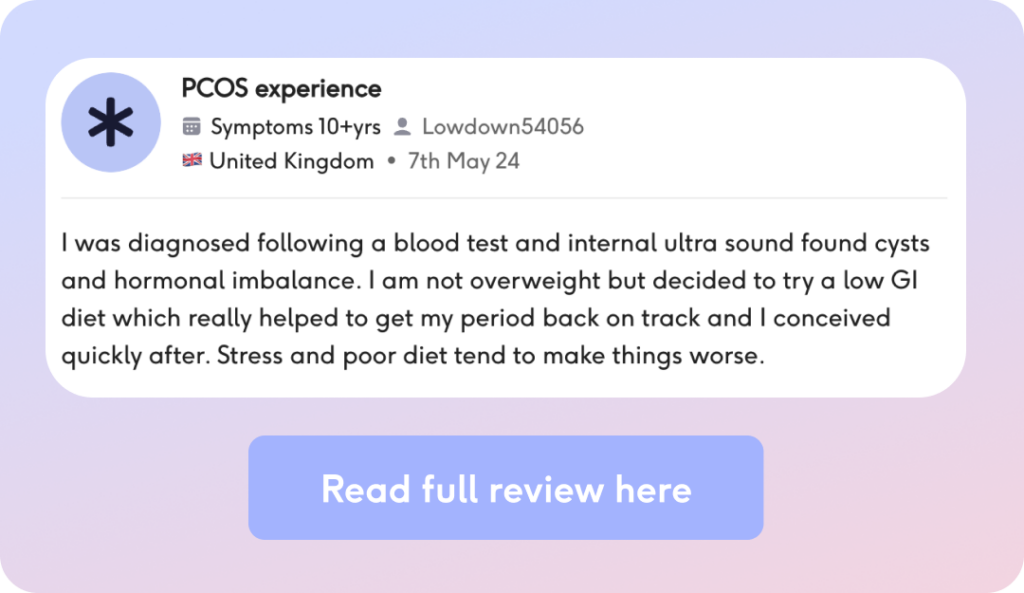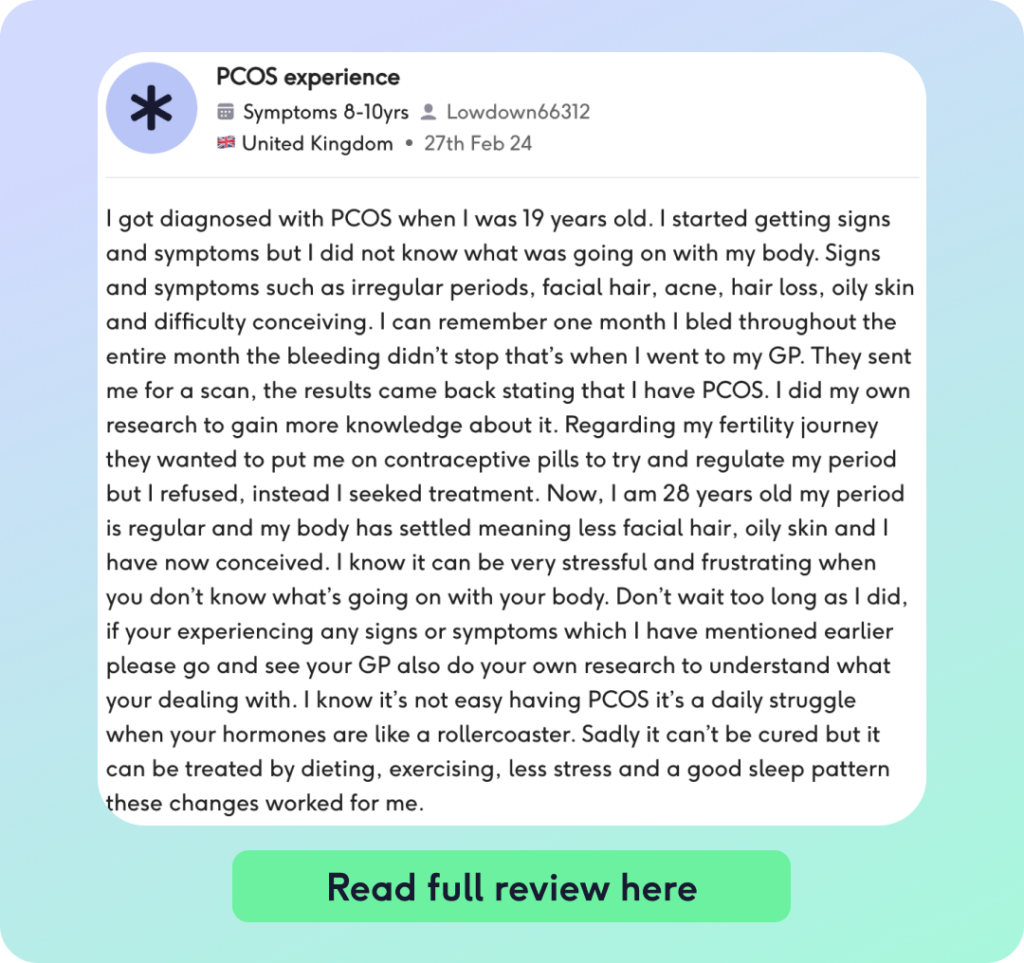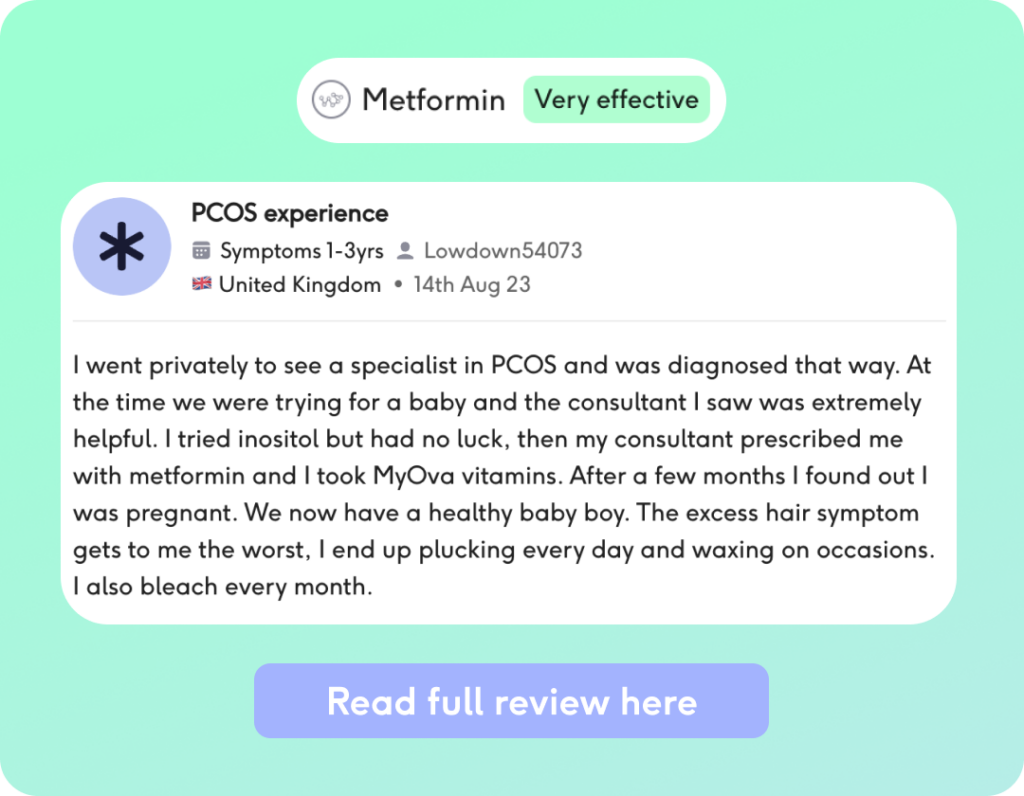
How to diagnose PCOS & what to expect
In this article
What's the lowdown?
PCOS affects around 10% of reproductive aged women and people with ovaries, although many are undiagnosed (2)
It usually presents with irregular or absent periods but is also associated with other symptoms
The Rotterdam criteria is used to diagnose PCOS in the UK and internationally
Treatments for PCOS can either be hormonal or non-hormonal
What is PCOS?
Polycystic ovary syndrome (PCOS) impacts how the ovaries function. The most common symptom is irregular, infrequent or absent periods1. Other recognised symptoms include2,3:
- Weight gain
- Excessive facial and body hair (hirsutism)
- Hair thinning
- Acne
- Difficulty conceiving (since irregular or less frequent periods mean less frequent ovulation and fewer fertile days, though pregnancy is often possible naturally or with medical assistance).
At The Lowdown, we frequently hear about additional symptoms like bloating, fatigue, and even snoring. However, experiences with PCOS vary greatly, and some individuals may have more symptoms than others.


PCOS can also affect women of colour differently, a phenomenon that is not yet fully understood but may be linked to a genetic predisposition to conditions such as cardiovascular disease and diabetes in certain ethnic groups. Health inequities are prevalent in the UK and much of the world, and there is a critical need for more research into how gynaecological conditions like PCOS affect people of colour. Improved care pathways are needed to ensure that this is recognised.
Despite the name “polycystic ovary syndrome,” there are no actual cysts on the ovaries. Instead, the ovaries are larger than usual and contain many small fluid-filled sacs, known as follicles, which contain immature eggs. The exact cause of PCOS is not fully known, but it is related to hormonal imbalances, particularly an overproduction of androgens (male hormones such as testosterone which are also present in female bodies) and reduced sensitivity to insulin, the hormone that controls blood sugar. Individuals with PCOS often have some resistance to insulin, which results in higher-than-normal insulin levels in the blood, prompting the ovaries to produce excessive amounts of testosterone.
PCOS diagnostic criteria
Diagnosing PCOS solely based on symptoms isn’t always possible, but if you have two or more of the following, you might have PCOS (assuming other potential causes have been excluded by your doctor). The criteria used to diagnose PCOS is the Rotterdam criteria for PCOS2,4:
- Irregular periods
- e.g., less than 21 days or more than 35 days between periods for adult premenopausal women) or the absence of periods.
- Elevated levels of androgens
- This can be detected by blood tests looking at different hormone levels in the body or by your doctor observing signs such as acne, excessive facial or body hair (hirsutism), or hair thinning in a female pattern. There is no specific PCOS blood test but
- Polycystic ovaries on ultrasound
- This is basically a standard ultrasound (usually transvaginal where the ultrasound probe is inserted into the vagina, but can be abdominal where the probe is placed over the skin of your abdomen) looking for the appearance of polycystic ovaries — not actual cysts, but multiple follicles. The person doing the scan uses specific criteria to determine if your ovaries have “PCOS morphology.”
- Alternatively, an elevated level of the hormone AMH (anti-Müllerian hormone) may be used instead of an ultrasound. 2 AMH testing has long been used in fertility clinics, and high levels have been linked to the appearance of the ovaries on an ultrasound. However, use of AMH blood testing has only recently been included in clinical guidelines and it might take time before AMH blood testing becomes a regular part of clinical practice.
It’s crucial to note that neither ultrasound nor AMH testing should be used to diagnose PCOS within eight years of your first period2, as many women may still have numerous follicles on their ovaries which is normal at this time. Interestingly, some women may have PCOS without the typical ultrasound findings, while others may show polycystic ovary morphology (PCOM) on a scan without meeting the criteria for the full syndrome. This complexity highlights that PCOS is a syndrome — a recognizable collection of symptoms — rather than a condition with a single cause or definitive test,which is why its classification and diagnosis may evolve in the future.
Treatment for PCOS
For those with PCOS, general health guidelines remain important: eat a balanced, nutrient-rich diet, exercise moderately, limit caffeine and alcohol, reduce stress, and prioritise quality sleep. Maintaining a healthy weight is beneficial but can be challenging with PCOS, which often makes it easier to gain weight and harder to lose it. Feeling tired or stressed can also reduce motivation for healthy habits like cooking or exercising. There is no specific diet or exercise regimen proven to be best for weight loss with PCOS; the most effective one is whatever you can stick to and enjoy. Focus on adding nourishing foods and activities rather than restricting yourself2,5.
Supplements and Medications:
- Inositol: A naturally occurring sugar found in supplements that can help manage PCOS symptoms. Research shows it may improve cycle regularity and reduce testosterone, glucose levels, and BMI6.
- Metformin: A medication for type 2 diabetes that enhances insulin sensitivity. It can also be prescribed for PCOS by specialists to aid in weight loss, improve insulin response, and promote ovulation5.
- Spironolactone: Often used for heart conditions, this medication may be used by specialists to treat acne and excessive hair growth (hirsutism) associated with PCOS5.



Hormonal contraceptives, like the combined pill, patch, or vaginal ring, can help manage symptoms by regulating menstrual cycles and lowering androgen levels. Pills with anti-androgenic progestins (like Yasmin, Drovelis, or Eloine) may be effective, though many standard pills work well too5.
Women with PCOS who don’t have regular periods (at least once every three months) are at higher risk of developing a thickened womb lining (endometrium), which can increase the risk of womb cancer. To prevent this, it’s necessary to either induce a bleed with hormonal medication every three months, or maintain a thin womb lining. Combined contraceptives and progestogen-only options (like the hormonal coil, implant, injection, or POP) can help with this, often resulting in fewer or no periods5.
For those not using hormonal contraception, progesterone tablets, such as medroxyprogesterone, can be taken for 10-14 days of each cycle to induce bleeding and lower the risk of endometrial cancer.
Summary
There is no one answer on how to test for PCOS, rather we look for is a combination of symptoms and findings from tests such as blood hormone levels and ultrasound which are needed in order to come to a diagnosis.
There is sadly no cure for PCOS, and it does not improve on its own. Treatments should be tailored to your body and needs. Sometimes contraception is not needed if you are getting regular periods. However, if your periods are very irregular, your doctor will often suggest starting contraception to regulate periods and reduce endometrial cancer risk. The best contraceptive option varies for each person, so it’s important to consult your GP or a healthcare professional specialising in gynaecology or reproductive health. Check out our contraception recommender or contraception comparison tools so you can be prepared for your appointment.
Our medical review process
This article has been medically reviewed for factual and up to date information by a Lowdown doctor.






